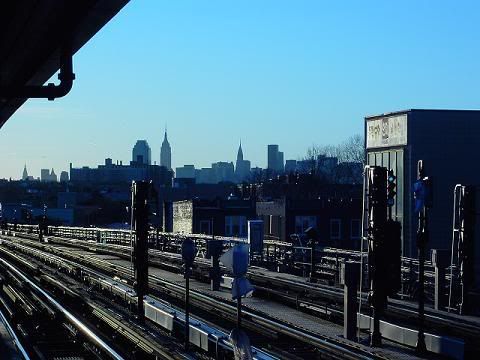Monday, October 8, 2007
Thesis and 2 Points
Introduced in 1965, the Immigration Reform Act had a lasting positive change on the neighborhood structure of Jackson Heights by creating a highly diverse population of immigrants.
2 Points of Evidence:
Vacant homes were sold to immigrant buyers who needed decent affordable housing near public transportation.
Immigrants helped recreate the business district of Jackson Heights by moving into the neighborhood and restarting businesses that were once abandoned.
Wednesday, October 3, 2007
Interview in Jackson Heights
1.) Do you live in Jackson Heights?
Yes.
2.) For how long?
About a year. A little less than a year.
3.) What area of J.H. do you live in?
I live on 103rd St. It's ok.
4.) What attracts you to J.H.?
It's always busy here, I like that. I lived in a boring place before. There's more here.
5.) Were you born in NYC?
No.
6.) How long ago did you move here and from where?
I came here when I was young, from Mexico.
7.) Which cultural group do you relate to?
Spanish.
8.) Do you feel any specific cultural group is more dominant here in J.H.?
No, it seems basically even I think. None more than the other.
9.) How do you feel different groups interact with one another here?
I think everyone gets along.
10.) What cultural changes have you noticed/ experienced while living in J.H.?
Not much, I don't think so.
11.) Have you experienced any cultural difficulty or conflict with another culture here?
None that I can think of. I'd say none.
12.) What have you noticed of the fluctuation of cultural groups here?
Seems level.
Monday, October 1, 2007
Questions of the Interview
2.) What area do you live in?
3.) Which culture do you most identify with?
4.) How long have you lived in Jackson Heights?
5.) How you experienced any cultural conflict while in Jackson Heights?
6.) What attracts you to this neighborhood?
7.) What changes have you experienced concerning the ethnic groups here?
8.) How do you feel all the different ethnic groups of Jackson Heights deal with each other(+/-)?
9.) Were you born in NY?
10.) What ethnic group do you feel is dominant in Jackson Heights?
Thursday, September 27, 2007
Historical II
NEAR EAST RELIEF BENEFIT.;
Referred to as the Blue and White Fete, a benefit was held for the Near East Relief in an attempt to relieve suffering for
Five tickets each costing one dollar were sent to each of the 1,000 families in the
For entertainment the
The Chairman of the committee, appointed by the
Historical II
Boundaries Keep Shifting, But Fears Remain the Same. New York Times.
The article discusses how the neighborhood borders of
Most of the complaints and expressed fear deal with the situations concerning drugs, prostitution, over-crowding, and noisy social clubs; few mention race as a problem.
At the beginning of the article, it is mentioned that the community of Woodside is predominately middle-class white and also mentioning that
Wednesday, September 19, 2007
7 Train

Yes, I did take this picture with my outdated camera… I know, it’s amazing.
A very important structure running through Queens from Manhattan Times Square to
Concerning the train I have witnessed a placard posted on the wall of the
In this photograph the train is absent, only leaving the tracks visible. These tracks are a technologically complex system of horizon strait metal and electrical systems used for monitored control. The train conductor also depends on a system of “red light stop, green light go” in the form of street lights for basic speed operation; also helping to keep the trains properly spaced. You can see from all the posts and plastic bags that this is an exciting place to wait for a train.
In the background you can see the
The picture took on a charming blue tint, reflecting the weather experienced that day. The sky was a lovely bright blue, and an equally pleasing temperature. I think the picture perfectly corresponds with the placid atmosphere of the day. Even looking at this picture now, I can feel relaxed from the tranquil coloring.
Research, Compilation
In the NYC borough of Queens, it has recently become the most ethnically diverse county in the
This immigrant movement is also reflected in the current demographic changes for the
* Jackson Heights CD403. 19 Sept 2007. http://64.233.169.104/search?q=cache:8BuiyWmfP38J:furmancenter.nyu.edu/CD403.pdf.pdf+jackson+heights+ethnic&hl=en&ct=clnk&cd=9&gl=us
** LayerInfo. 19 Sept 2007. http://nychanis.com/NYU/NYCHANIS/Map/Layerinfo.aspx
Miyares, Ines M. From exclusionary covenant to ethnic hyperdiversity in Jackson Heights, Queens. 2004. 19 Sept 2007 http://www.accessmylibrary.com/coms2/summary_0286-11987263_ITM
